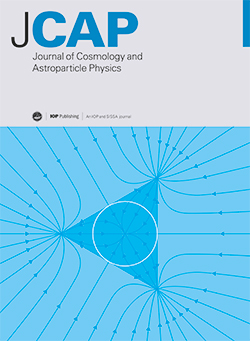Primordial black hole formation from type II fluctuations with primordial non-Gaussianity
IF 5.3
2区 物理与天体物理
Q1 ASTRONOMY & ASTROPHYSICS
Journal of Cosmology and Astroparticle Physics
Pub Date : 2025-02-11
DOI:10.1088/1475-7516/2025/02/018
引用次数: 0
Abstract
This study investigates the formation of primordial black holes (PBHs) resulting from the collapse of adiabatic fluctuations with large amplitudes and non-Gaussianity. Ref. [1] showed that fluctuations with large amplitudes lead to the formation of type B PBHs, characterized by the existence of the bifurcating trapping horizons, distinct from the more common type A PBHs without a bifurcating trapping horizon. We focus on the local type non-Gaussianity characterized by the curvature perturbation ζ given by a function of a Gaussian random variable ζG as βζ=-ln(1-βζG) with a parameter β. Then we examine how the non-Gaussianity influences the dynamics and the type of PBH formed, particularly focusing on type II fluctuations, where the areal radius varies non-monotonically with the coordinate radius. Our findings indicate that, for β > -2, the threshold for distinguishing between type A and type B PBHs decreases with increasing βsimilarly to the threshold for black hole formation. Additionally, for large positive values of β, the threshold for type B PBHs approaches that for type II fluctuations. We also find that, for a sufficiently large negative value of β ≲ -4.0, the threshold value is in the type II region of μ, i.e., there are fluctuations of type II that do not form black holes. Lastly, we calculate the PBH mass for several values of β. Then we observe that the final mass monotonically increases with the initial amplitude within the parameter region of type A PBHs, which differs from previous analytical expectations.求助全文
约1分钟内获得全文
求助全文
来源期刊

Journal of Cosmology and Astroparticle Physics
地学天文-天文与天体物理
CiteScore
10.20
自引率
23.40%
发文量
632
审稿时长
1 months
期刊介绍:
Journal of Cosmology and Astroparticle Physics (JCAP) encompasses theoretical, observational and experimental areas as well as computation and simulation. The journal covers the latest developments in the theory of all fundamental interactions and their cosmological implications (e.g. M-theory and cosmology, brane cosmology). JCAP''s coverage also includes topics such as formation, dynamics and clustering of galaxies, pre-galactic star formation, x-ray astronomy, radio astronomy, gravitational lensing, active galactic nuclei, intergalactic and interstellar matter.
 求助内容:
求助内容: 应助结果提醒方式:
应助结果提醒方式:


